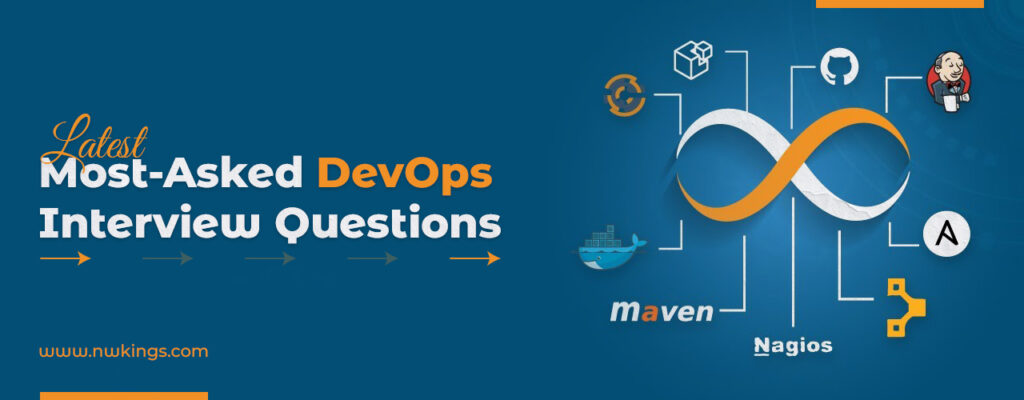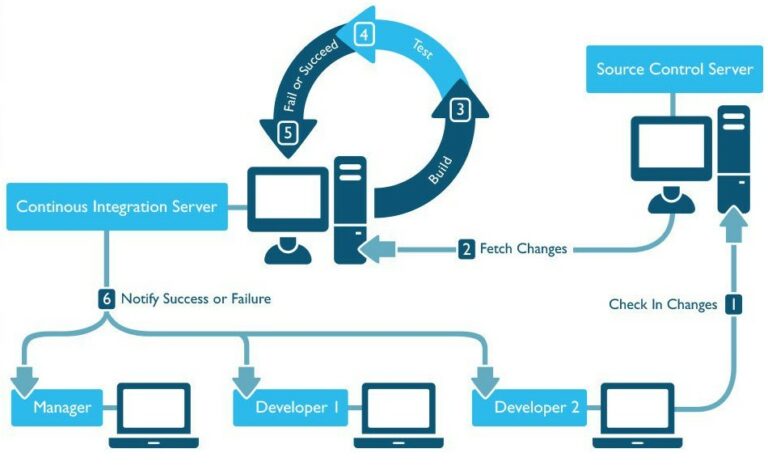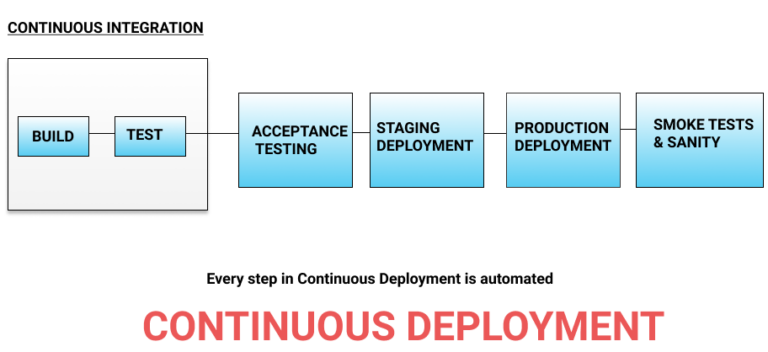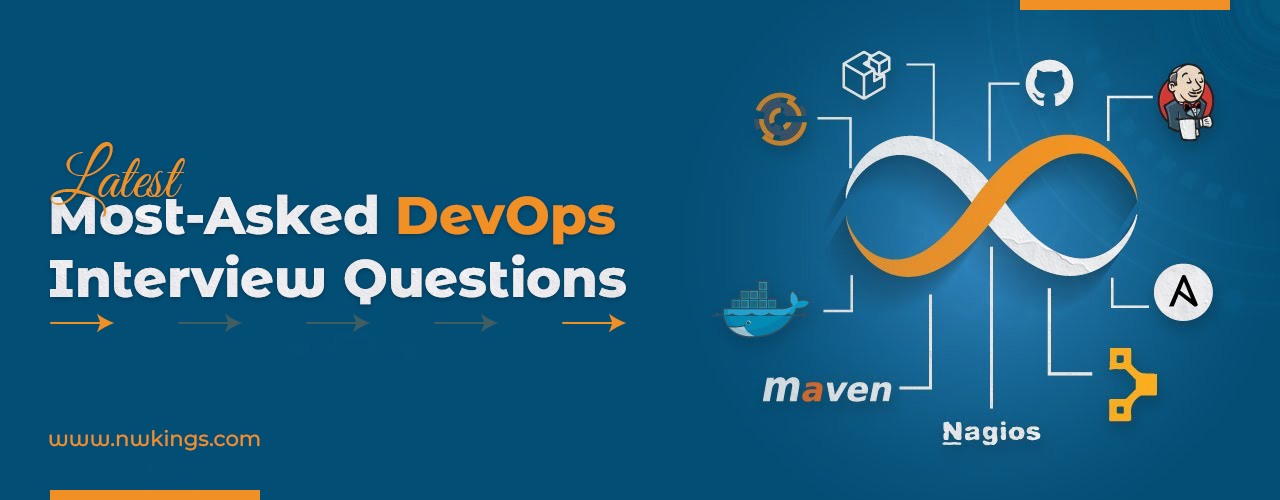
DevOps has taken over the IT industry, considered the trendiest job title or revolutionary technology. This has led to an increased demand for DevOps professionals in the industry. Although it’s a difficult task to break in as a DevOps Engineer considering the competitive environment, you can sharpen your skills by going over our guide of the top most-asked DevOps interview questions and answers.
To make it easy for you to prepare, we have divided a bunch of DevOps engineer interview questions for freshers and advanced-level professionals. Without further ado, let’s now begin with the DevOps interview questions and answers.
DevOps interview questions for freshers
1. What is DevOps?
DevOps is a software development methodology that combines development (Dev) and operations (Ops) to increase collaboration, communication and integration between software development and IT service teams. It focuses on automating applications, using agile methodologies, and creating a culture of continuous improvement and feedback-encouraging loops.
2. Explain the basic principles of DevOps.
The basic principles of DevOps are:
- Collaboration between different teams: To encourage cross-functional teams to work together and share responsibilities.
- Automating tasks for ease: DevOps improves system efficiency and reduces errors by automating repetitive tasks.
- Using Continuous Integration and Continuous Deployment (CI/CD) pipelines: Makes sure that all the changes in the code are integrated frequently and deployments are automated for the production environment.
- Managing Infrastructure as code (IaC): DevOps encourage the scalability of applications by using version-controlled codes and managing infrastructure accordingly.
- Analysis and Response: With the use of various monitoring and logging tools, the collected data can be analyzed easily. Quick reports could be made to resolve the problems instantly.
3. How does DevOps differ from conventional Waterfall development?
Waterfall | DevOps |
The waterfall is an old and traditional method of developing systems. It develops in different stages: requirements, design, development, testing, and deployment. | DevOps is a brand-new approach to developing efficient systems by combining development processes and IT operations. It gives the best results through continuous integration, continuous delivery and continuous testing. |
Simple, small-scale software development projects that are quite predictable can be applied to the waterfall development. | DevOps consists of teams combined efforts and automation to work on various developmental tasks of all spectra. |
Every phase occurs after the previous phase is completed. There is no feedback provided on the development process. | It allows frequent and quick changes. |
4. What are the important elements of a DevOps environment?
Key elements of a DevOps environment include:
- Version control: Using tools like Git to track and track changes to source code.
- Configuration management: Automation tools like Ansible, Chef, Terraform are used to automate infrastructure provisioning and configuration.
- Continuous Integration (CI) server: It automatically builds, tests and integrates code changes.
- Deployment automation: Application deployment is automated by using tools like Kubernetes, Jenkins, etc.
- Monitoring and logging: Collects application performance and logs to troubleshoot for efficient application output.
5. How do you handle security in a DevOps world?
Security plays an important role just like quality. With the onset of CI/CD pipelines, changes can be made quickly and can be shipped into the production efficiently. Earlier, security checks were made after the whole application had been completed and before the deployment process.
But no one has the time to do such an extensive security check as the process could take even 2 weeks for the complete security audit. Therefore, security is kept in check by the following 2 ways:
- Integrated security check along with code: So, with DevOps, the task of security check is shifted to the developers. Now, security is checked while the code is tested for its functioning.
- Build security checks into CI/CD pipelines: During the building process, security scans can be done. This makes sure that there are no credits deployed in the source control system.
This way, the security is incorporated into the process instead of tackling it later on.
6. What is meant by Continuous Integration (CI)?
Continuous integration is a software development practice where everyone in the engineering team is continuously incorporating small code changes back into the codebase(Source Control Server). After each change that they’re making, there’s a suite of tests that runs automatically that checks the code for any bugs or errors.

The above image shows how developers incorporate changes in the codebase as the test is passed.
7. What is Continuous Deployment (CD)?
The following are the stages in a continuous deployment:
- Build and test: It is also an engineering practice where the changes made in the code by a developer would undergo build and test stages. Once the build activity is done, a code package is generated. The code is now packaged with all the libraries and binaries.
- Acceptance testing: It is then sent for acceptance testing. In this step, the code packages or artifacts are tested with respect to performance, code duplicates, code vulnerabilities, and all the security aspects, etc.
- Deployment to staging area: Once the code passes the acceptance test, it cannot be directly sent to the production stage. This is why it is sent for deployment in the staging area where it is tested in a local environment.
- Deployment to production area: Finally, the code package is sent to the production area. Then smoke testing is carried out to check the code functionality. You must note that all these steps of deployment and smoke testing are automated by tools such as Selenium, etc.

8. Explain the concept of Infrastructure as Code (IaC).
- Earlier, a traditional method of raising a ticket manually was followed to administer infrastructure resources.
- However, with the adoption of cloud environments, cloud elasticity has allowed the management of infrastructure through the usage of code to define and administer infrastructure resources. This approach is called Infrastructure as Code (IaC).
- IaC allows you to use code to design and deploy infrastructure in place of manually configuring servers, networks and other infrastructure components.
- The code is often used in the form of declarative configuration files.
- This has also allowed the automation of infrastructure deployments.
9. What is containerization in DevOps?
- Containerization is a method of packaging and deploying applications in a light-weight, portable container consisting of all the important components such as code, libraries, and runtime, to run the application.
- Containers allow applications to be easily moved between different environments such as from development to production environment, without worrying about compatibility issues or missing dependencies.
- They provide a consistent isolated environment for applications to run. This makes it easier to manage and deploy applications.
- Containerization is mostly carried out by using platforms like Docker. This platform provides tools and frameworks for creating, managing and deploying containers.
10. Name some of the popular DevOps tools.
- Version Control Systems: Git, SVN
- Continuous Integration/Continuous Deployment (CI/CD): Jenkins, Travis CI, CircleCI
- Configuration Management: Ansible, Chef, Puppet
- Monitoring and Logging: Prometheus, ELK Stack (Elasticsearch, Logstash, Kibana)
- Collaboration and Communication: Slack, Jira, Confluence
- Infrastructure Provisioning: Terraform, CloudFormation
Containerization and Orchestration: Docker, Kubernetes
DevOps interview questions and answers for experienced professionals
11. How is high availability ensured in DevOps environments?
You can follow the below-mentioned practices to ensure high availability in DevOps environments:
- Make use of redundancy: By installing and setting up redundant systems, you can reduce points of failure. This can make the whole DevOps environment quite highly available.
- Disaster recovery planning: Reduce downtime in case of failures by creating backups and deploying recovery strategies.
- Automate the process of scaling: Scaling is a very important aspect of DevOps when it comes to ensuring high availability. The process can be automated by using tools such as Kubernetes.
- Monitoring and logging: All the issues related to monitoring and logging can be resolved quickly and efficiently. This could be done by making use of advanced and sophisticated monitoring systems.
12. What is meant by Blue-Green deployment?
You can consider the blue-green deployment as a deployment strategy to avoid any downtime during any deployment. As the name suggests, the “blue” and “green” are two similar production environments. There could only be one production environment active at a time, for example, serving production traffic.
Whenever the first production environment faces a downtime or any issue, the second production environment takes over and becomes active.
13. How is configuration management handled in DevOps?
Configuration management is used to manage and keep consistent configurations across diverse environments. The following are some techniques for handling configuration management:
Using configuration management technologies like Puppet, Ansible, and Chef, it is possible to automate the provisioning and configuration of infrastructure resources.
- (IaC) Infrastructure as Code:
Through the usage of IaC, tools like CloudFormation or Terraform may be used to describe infrastructure configurations in version-controlled files.
- Disposable servers and containers:
This implies that new instances are created with the desired configuration whenever a new configuration is necessary. Because of this, a new instance of the infrastructure is created every time an update is done. Business organisations can create a more stable, predictable, and scalable environment by employing this strategy.
14. Mention all the KPIs that are used for estimating success of a success team?
Key Performance Indicators (KPIs) are the principle factors that can help in measuring the effectiveness of a DevOps software development pipeline and allow us the space to identify shortcomings in the current strategies.
The various KPIs are mentioned below:
Lead time for changes:
- It is the difference in the time between when a new code is made to when it is built and deployed.
- This KPI is useful to measure the deployment efficiency of a DevOps team. It also helps to measure expertise of software developers.
Change failure rate:
- There are often some deployment changes that need urgent attention. The change failure rate indicates those changes.
- Therefore, it is an important KPI in checking a DevOps team’s code testing efficiency and the code quality.
Deployment frequency:
- Deployment frequency is a KPI that measures how often a new code is pushed into a production pipeline.
- Even though a DevOps team deploys code regularly, there could be deployment frequency issues.
- Deploying on demand and getting constant feedback is a good way to improve deployment frequency.
Mean time to recovery:
- Whenever a deployed application faces failure/downtime, the time it takes to return to its normal operations is referred to as the mean time to recovery.
- With the help of monitoring and logging techniques, the root cause of downtime can be identified and thus, mean time to recovery can be reduced.
Customer ticket volume:
- It is an important KPI to measure how efficient a program is in meeting the needs of the customers.
- If you receive a high number of customer tickets, it would indicate high customer dissatisfaction.
- It is important to segment various tickets to resolve them quickly and efficiently.
Defect escape rate:
- This KPI defines whether the code containing errors/bugs is released into the production pipeline.
- It is a good measure for gauging if the team is making production enhancements very fast.
Application performance:
- This KPI measures the working and response of an application during peak and normal operating conditions.
- A low application performance indicates decrease in demands. It requires intellectual handling and resolution.
Mean time to detection (MTTD):
- This KPI measures the time period it takes right from a problem occurring in the production pipeline to when it is resolved.
- This KPI is dependent on other KPIs such as mean time to failure and mean time to recovery.
15. When do Agile and DevOps work together?
DevOps might be seen as Agile’s progressive method or Agile’s missing element, it is an attempt to apply innovations of Agile methodologies to operational procedures. DevOps is also a missing piece in Agile as most of the Agile concepts are only fully fulfilled when DevOps methods are implemented.
For example, Agile documents contain many references to continuous software delivery but since delivery pipelines incorporate operational issues, continuous delivery is often seen as a DevOps strategy that amplifies feedback loops.
By using Agile and DevOps together, a company’s objectives can be reached quickly and efficiently. Therefore, it is considered a cultural evolution. Agile and DevOps function better together as competitors.


